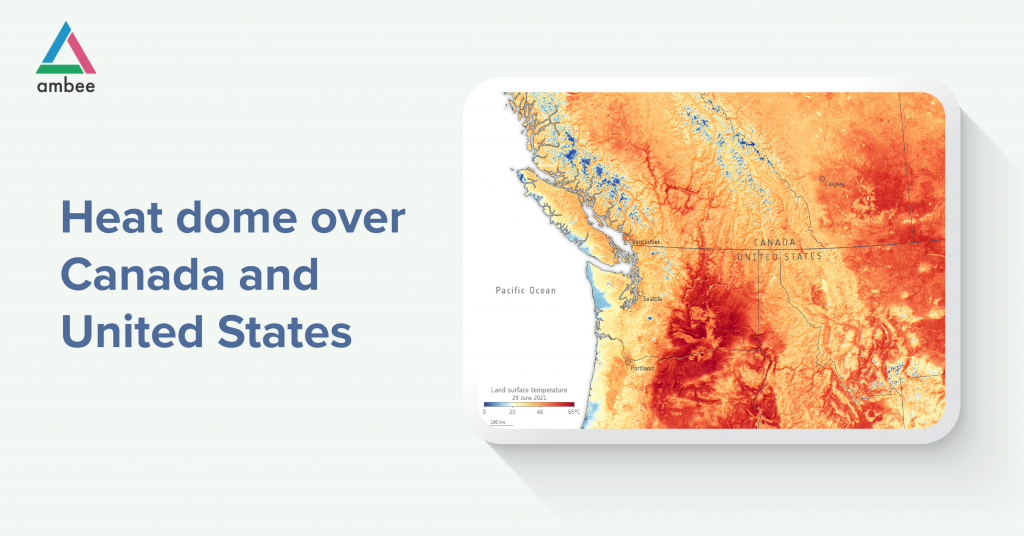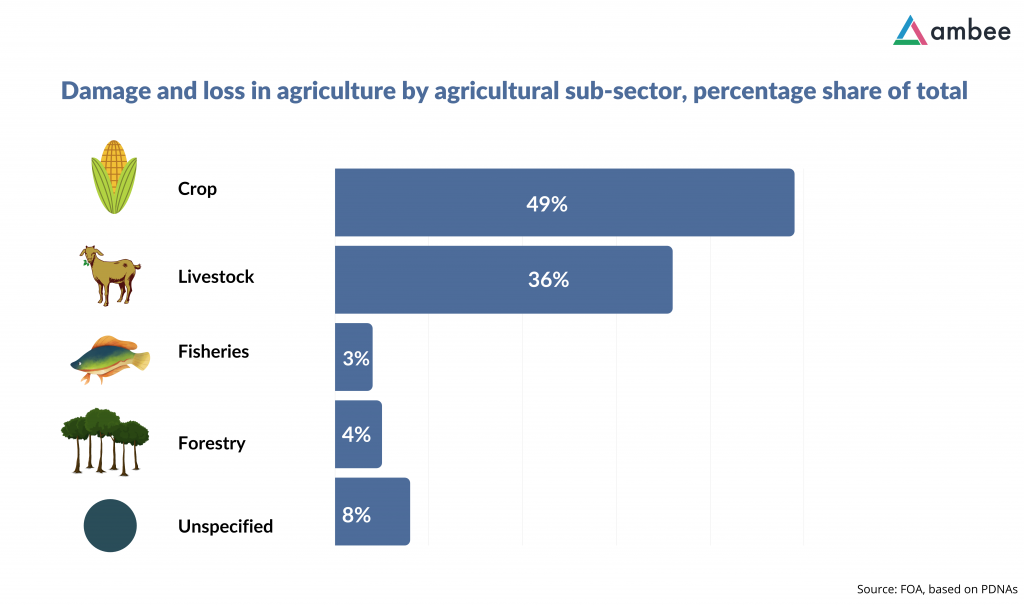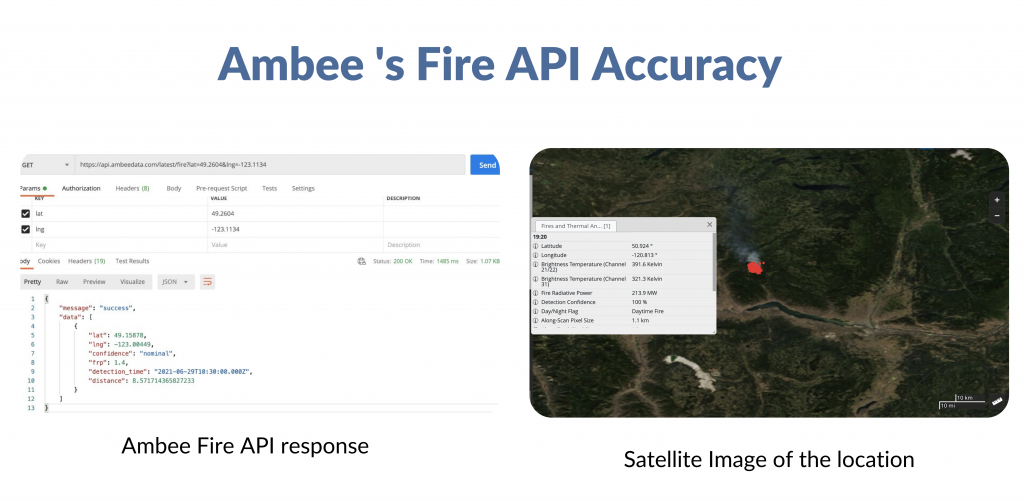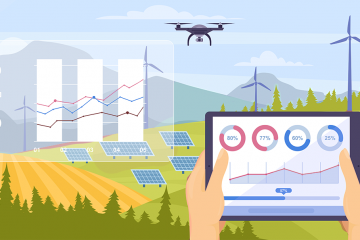Idea in brief:
- Heatwaves have led to a rise in temperatures of up to 50°C (122°F) in Canada and the US Northwest, adversely impacting local businesses and income (GDP).
- Multiple industries are affected by these adverse and inclement weather conditions. These include agriculture, energy, construction, healthcare, and insurance.
- Just the healthcare and agriculture sectors alone stand to lose more than $225 billion to natural disasters. However, help is at hand.
- This article explains how individuals and businesses can use accurate, granular, real-time air quality, fire, and weather data to plan for such disasters.

In many parts of the US Northwest and Canada, the temperature is at a scarcely-believable 50°C. This terrain, generally known for its cool and rainy climate, is experiencing a blistering heat wave predicted to continue till the end of July 2021. Though the leading cause of rising temperatures may be up for discussion, businesses can’t deny that the heatwave has had a massive impact on their businesses and the economy.
In the past month, heatwaves boiling over Canada and the US Northwest have directly influenced energy costs, the food we eat, the roads we drive on, and, most importantly, our healthcare expenses. It significantly damages the biological balance of the ecosystem and has even resulted in devastatingly low businesses during the 4th of July weekend. Companies from various verticals such as retail, energy, agriculture, construction, healthcare, and F&B have reported a loss due to the heat dome effect. Some sectors, more than others, have experienced loss at an enormous scale.
Profits Going Up in Smoke – The Agriculture Sector
Agricultural losses stemming from heat waves have tripled in the last few years. As a result of the spiked temperatures, 49% of the pastures have dried out, and the death of cattle has skyrocketed from 10.8% on average to 36% during disasters like the current heatwave, followed by drought. Cotton crop growers lose almost 50% of their crops when harvesting. Thousands of acres of corn crops have been wiped out due to excessive heat. Heatwaves also kickstart a domino effect, with a price hike and loss to the economy. Minor reductions in crop yields trigger a chain link of losses cascading down to agricultural growth and livelihood.

We need to take steps to protect our planet and our economy by guarding against sudden variations in climate. To do so, environmental intelligence companies such as Ambee monitor weather, water vapor, and soil data to ensure awareness and prepare agriculturists. By monitoring the health of farmlands, precautions can be in place to avoid damage from extreme climatic conditions.
Risk of Loss & Life – Construction Industry
Highways and railroads are splitting open in extreme heat, causing transportation hazards for commuters. The thermal expansion of materials severely affects components like concrete and steel. As they are fixed in place, the tolerance for expansion reduces drastically, resulting in buckling.
Extreme temperatures increase the probability of accidents in a construction site. Poor visibility, dehydration, and sunstroke all have the ability to affect the judgment and reaction times of the workers. This situation is particularly perilous while operating heavy machinery or dealing with chemicals. Workers may succumb to the temptation of not wearing personal protective equipment (PPE), resulting in higher risks of accidents, especially around hazardous construction materials.
Construction companies can integrate weather and air quality APIs into their building information management (BIM) & CRM platforms to ensure the protection of their workers. Appropriate health and safety norms combined with environmental data can save workers from natural disasters like heat domes.
Testing Capacities of Care – Healthcare Sector
Extreme heat puts a strain on healthcare systems and their amenities. The heatwaves aren’t just making us more ill; they’re also becoming more lethal. Healthcare providers need to understand and anticipate these disasters to better prepare for the treatment of patients.
There is always a sense of chaos and confusion during natural disasters. Regardless of how prepared civilians are, they are often the first to be affected. The baton to take control over public health and treat the patients efficiently passes over to healthcare systems. Environmental intelligence companies can help the healthcare sector and digital health monitoring systems monitor, prepare, and alert patients. During the 2003 European heatwaves, an estimated 70,000 additional people died due to the heatwaves. In the United Kingdom alone, the estimated impact of this heatwave was £41M in health-related costs and productivity. With environmental data in place, weather forecasts and temperature hike alerts can help companies plan for low productivity days and allow hospitals to stock up on medication.
High Dependency Low Efficiency – Energy Sector
Turning on your air conditioning when it’s hot outside is the easiest thing to do, but this has some rather devastating long-term effects. Power grids are already strained during summers, as more and more people rely on air conditioning to stay cool. More pressure to meet the demands during heat waves results in a shutdown or, worse, revert to using “peaking plants.” Not only are these plants expensive to operate, but they also tap into the emergency reserves of natural gas.
Electricity costs in summers have ballooned over the last few decades. The only way to control demand is by metered use of electricity. Electricity companies have begun urging people to conserve electricity by monitoring their power consumption. Using tons of AC will have only a short-term impact on your power bill. But, more significant effects like greenhouse gases (GHG) emissions worsen the air quality. Power companies can rely on environmental intelligence to plan their generation times, the duration of electricity supply and take notes from the weather to prepare for situations like the heatwaves and avoid overheads.
Maintaining Stability With Environmental Data
Drought-ridden communities across the country have canceled fireworks shows during the 4th of July weekend. They have also banned the sale and use of personal fireworks until rains reduce the chance of wildfire. People are already on edge – recent wildfires in Colorado have burned nearly 700,000 acres across the country, with more than 3000 firefighters still trying to douse the fires.
We have always taken the short-term view on these issues, and it’s time we change that. Using a smart thermostat to turn on air conditioning ten minutes before arriving home or putting an energy management policy amongst employees can make a huge difference to saving our planet. The gap between wildfires is decreasing, and monitoring them is becoming a necessity. The scorching heat is likely to stay, and soon the heatwaves may not be just waves but trigger another episode of wildfires. Ambee’s fire data helps governments and companies to manage these erratic wildfires better. Alerts from Ambee’s fire intelligence can help governments detect wildfires early and initiate evacuation hours ahead of the fire.

Ambee’s environmental intelligence is accurate, hyper-local, and available in real-time. Its air quality and fire data can determine the most effective methods to save people and manage disasters. Ambee’s data can provide recommendations, alert its users to stay protected, and follow best practices during disasters like heat waves and wildfires. Integrating with Ambee’s environmental intelligence allows corporations to take steps to protect our planet, our economy, and most importantly, our people.
Check out Ambee’s fire detection API
About Author

A writer, nature lover and an environmental engineer. You can find me at Ambee’s office working with an amazing team to bring about positive change to our planet’s health. Being a big advocate of our environment, I write about technologies like AI, ML and Big data and its potential to save humankind from global warming.




